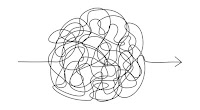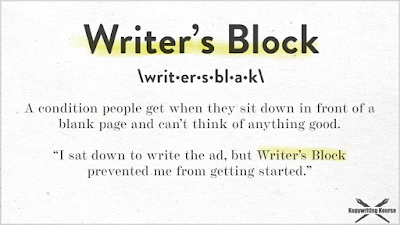THESE FOUR (4) STRATEGIES TO BEAT WRITER'S BLOCK HAVE BEEN PROVEN TO BE EFFECTIVE FOR OTHER WRITERS. GIVE THEM A TRY AND LEARN TO WRITE EVEN WHEN YOU DON'T FEEL MOTIVATED.
 |
| From The New York Times |
How to Beat Writer's Block Even When You Don't Feel Like Writing
by: Kel AmstutzMarch 24, 2020
 All writers face writer's block at some point or another. It's a THING. A fact of life. As professional writers we have to know how to get past it and... write anyways... even when we don't feel like doing it.
All writers face writer's block at some point or another. It's a THING. A fact of life. As professional writers we have to know how to get past it and... write anyways... even when we don't feel like doing it.
It's like there is a piece of cake sitting on the table in front of us. It's not like most cake... Nope, it's delicious, decadent, moist and rich. Someone slipped it into the microwave just a few seconds ago, so the scent of the warm chocolate is drifting over to wrap you up in it. The whipped buttercream frosting adds just the perfect crowning glory.
(Feel free to imagine your own favorite indulgence... I mean, if chocolate cake isn't your thing.)
This piece of chocolate cake is a feast to your eyes, and you can almost taste it hitting your tongue in an explosion of chocolate goodness and let's be real... joy.
But... there is a barrier between you and the chocolate cake. You can see the cake just fine. You can even smell it. But... you can not quite reach it.
If you want the cake bad enough.... you will figure out a way to get past this invisible barrier that is keeping you from it.
Well.. the same is true for getting past writer's block.
 Four Strategies To Get Past the Barrier
Four Strategies To Get Past the Barrier
Here are four (4) strategies that have helped me... and other writers I know... get past the invisible barrier... and help get us to our figurative chocolate cake.
STRATEGY 1 - WARM UP
There have been way too many Saturday mornings that my pre-teen has grumbled and resisted getting up early for a family event... or to run an errand. She would much rather sleep in on her sacred weekend. But, she pulls herself up and out of bed, gets herself ready... and we get moving on out the door. (You know... before COVID-19 and all!)
Once she gets moving, the resistance fades away, and she becomes more human and less zombie.
The same can be said for Singers who warm up their vocal chords by singing scales. Runners warm up by stretching, getting their blood moving.
Well... Writers warm up... by writing!
Well... Writers warm up... by writing!
So... write a headline or a title. You can always change it later. You are by no means stuck to keeping it the same in the draft phase of your writing.
Write out random ideas as they present themselves to you. You can go through and soft them out later - and choose if you want to keep them or simply delete them.
The things is to get your fingers moving. This activity will jump-start your brain. And, your writer's block will simply dissolve.
STRATEGY 2 - START WITH THE END IN MIND
If I am just not sure of my lead or how I want to get started... I work on the rest of the piece. Of course, this doesn't work for short copy pieces like PPC ads and some of the product descriptions. But, for mid- to long- form copy, this is an excellent strategy to get past writer's block.
 Write bullets. Write subheads and section heads. Write sidebar copy, if your piece will have sidebars. Write the stories you will use to illustrate your ideas.
Write bullets. Write subheads and section heads. Write sidebar copy, if your piece will have sidebars. Write the stories you will use to illustrate your ideas.
The action of working on the project puts your brain into gear. For me, skipping the beginning and working on the rest of the piece allows the idea for the beginning to just come to me. Once I am in the flow of my writing, other ideas begin to flow, too.
STRATEGY 3 - REMEMBER WHY YOU'RE WRITING
John Lennon and Paul McCartney, Beatles legends, are famous (at least among us writers) as saying, "Let's write a swimming pool" before sitting down to write a new song. They were setting an intention to earn enough money from writing the song that they could put a swimming pool in their backyard... or whatever else they wanted to buy or do with the money earned from the song they wrote.
If you are a professional writer - or someone is paying you to write - this applies to you, too.
Are you writing a college education for your kids? Are you writing a new car? A vacation? Food on the table? Your way out of debt?
Whatever it is that you are writing for, be clear on your WHY that is behind your choice to write for money. Then, remind yourself that your WHY is bigger than the distractions that you're using to not write. It is bigger than your writer's block!
STRATEGY 4 - GO FOR THE DISTRACTION
I can hear you... right now you are saying, "What? Go for the distraction? I thought my why is supposed to be bigger than the distractions!"
Well, when you are having a hard time getting started on a project, it is!
But, when you hit writer's block after you have been working on a project for several hours, it may be a sign that you simply need to take a break. That is the scenario I am addressing here.
 Sometimes writer's block is a sign of mental exhaustion. Your brain is telling you it needs a break.
Sometimes writer's block is a sign of mental exhaustion. Your brain is telling you it needs a break.
In this situation, get up, take a walk... or do some yoga... or clean off your desk... or do some laundry.... or load the dishwasher... or sit in the sun and mediate. All these things could be extremely helpful in helping you find your center again.
Try creating the invoice you are going to give your client with the finished project. Or pay some bills. These distractions have the added benefit of also reminding you of your why.
These "distractions" can give your brain a needed rest and let you return to writing feeling recharged and ready to go once again.
Just be mindful that the distraction is a solution only when you really are in need of a mental break... not when you are avoiding getting started in the first place.
WHICH STRATEGY IS BEST TO GET PAST WRITER'S BLOCK?
I have used each of these strategies to get past my own writer's block. They all work. Which one you choose at any given time depends on what is causing our block.
For example, you would not choose the warm-up strategy if you have hit writer's block AFTER you were writing for a few hours. In this situation, you probably just need a break... go for the distraction, like a walk.
If you are having trouble getting started, you would want to try the warm-up strategy or the start-with-the end-in-mind strategy.
The strategy of remembering your why is helpful whenever you are feeling unmotivated or when you are tempted to keep scrolling through your Facebook or Instagram instead of getting down to work.
I would love to hear how YOU get past your writer's block and get writing, even when you just don't feel like it.
Leave a comment below and share your best strategies!!!





























































